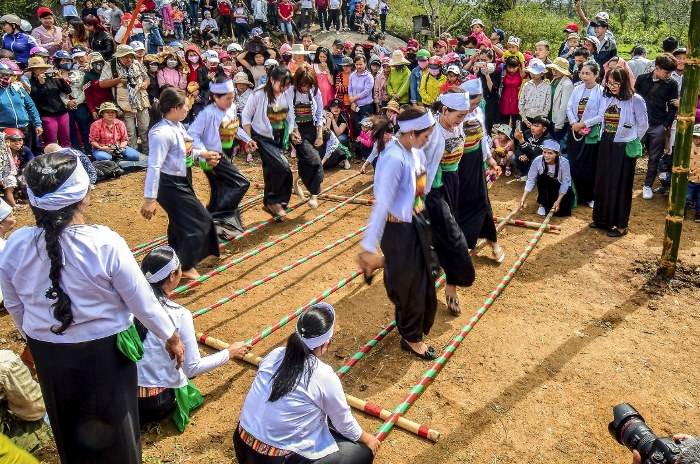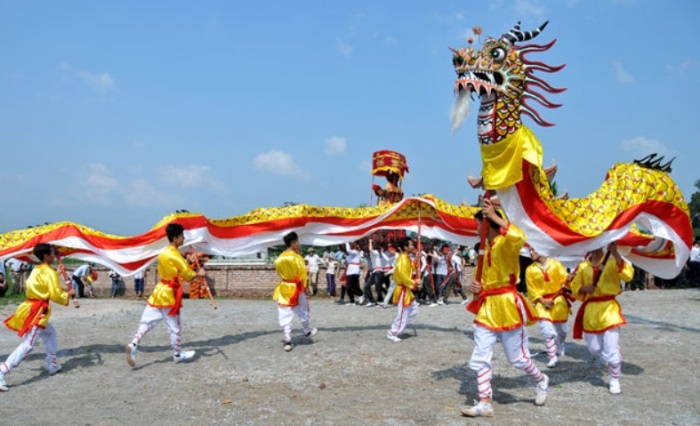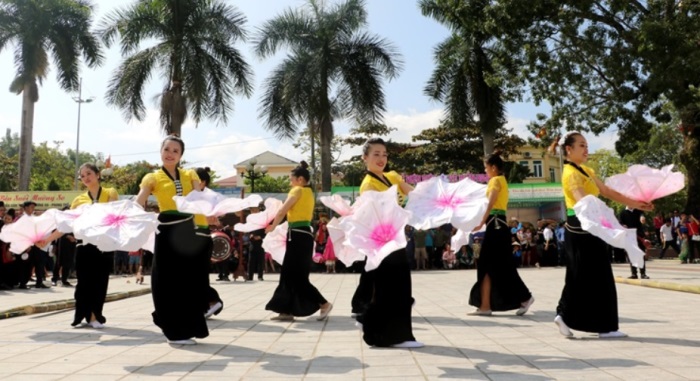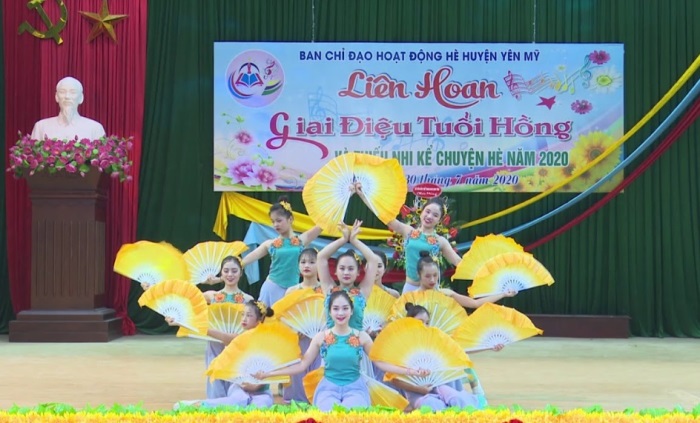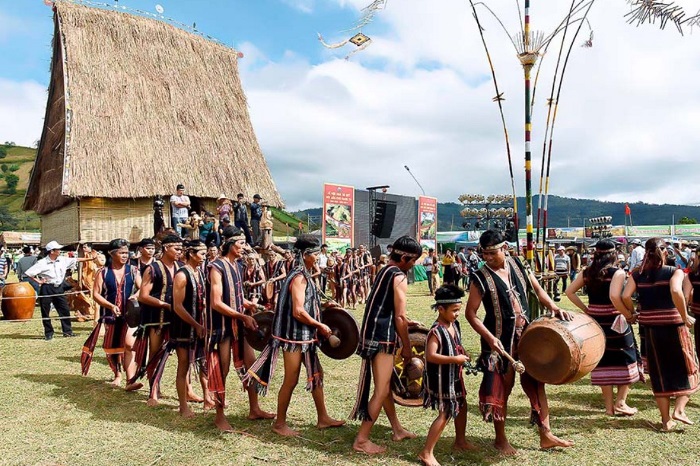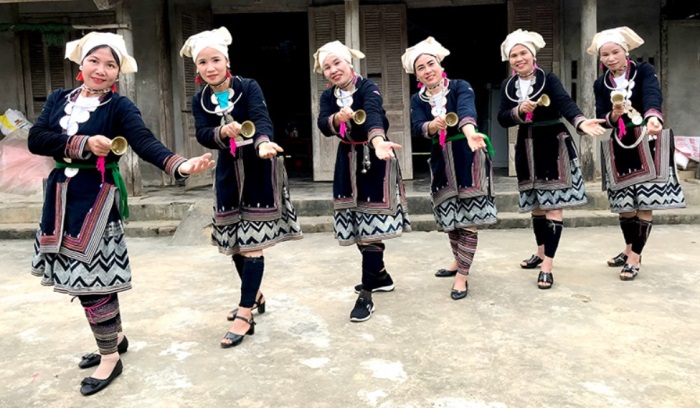With a territory divided into several regions and each of them having unique cultural traits, there are so many traditional Vietnamese dances carrying deep meanings and rich stories.
Now we will have a quick tour across the country and see what uniqueness the people have poured into their local dances.
Table of Contents
10 Popular Traditional Vietnamese Dances
Bamboo Dance (Múa Sạp)
The Bamboo dance has various regional versions, though most resources point back to the Philippines (Tinikling dance) during its Spanish colonization.
The legend explains that it was a punishment for field workers at first but became art and entertainment once they figured out how to dodge and have fun with the moves.
When the dance traveled beyond the border of the Philippines, it stayed with the Thai folks residing in the Northwestern region of Vietnam.
Due to its joyful nature, it has always been part of festive occasions.
Aside from villagers gathering and celebrating, young men and women also take the chance to bond with the person they like and possibly fall in love.
Anyone can join the Bamboo dance, though they will be divided into two groups: one would control the bamboo bars and one would jump.
The core of the music is the sound of bamboo poles clapping together, accompanied by the signature instrumental of the region.
The bamboo holders would put two large bamboo trees horizontally as the bases and smaller bamboo bars vertically so they have a net.
When they clap the trees, they would start at a slow pace and slowly speed up if they want to make the performance tricky.
Each dancer would hold a scarf while stepping into the net and bouncing in rhythm with the claps. The pace is very important since they must maintain a cheery atmosphere and rapidly change directions without getting stuck between the bamboo trees.
Lion Dance (Múa Lân)
Originating from China, the original Lion dance is mostly divided into two forms: Southern and Western.
Due to the influence of the diaspora groups, the Southern Lion dance predominates in Southeastern countries.
In Vietnam, the dance is called “Múa Lân” (“Lân” is similar to Qilin in Chinese culture) or “Múa Sư Tử” (“Sư Tử” is the direct translation of Lion).
Even in the country, it has numerous adaptations from the minorities, and the court performance for it has unique features as well.
You will mostly see the Lion dance in Vietnam during significant holidays or grand events such as opening ceremonies, religious festivals, or Lunar New Year.
The reason might come from the animals symbolizing this dance, for lions and unicorns in bright colors are the definition of festive and fortune.
As the occasions vary, the songs to perform will also change, yet the quintessence of them all is the drums played in many tempos.
Drum sounds are jolly and powerful at the same time, matching the acrobatics and martial arts included in the dance.
Furthermore, the mandatory part of the dance is Ong Dia (literal translation: Mr. Earth), a god of Earth in Vietnamese culture.
People here believe he is the protector assuring a peaceful and safe life for their locality. His appearance in the Lion dance indicates the intimate connection between humans and animals.
Dragon Dance (Múa Rồng)
In parallel with the Lion dance, you will also spot the traditional Vietnamese dragon dance in grand ceremonies and important celebrations.
Dragon is always a holy creature in Asian cultures, symbolizing luck and health. Therefore, its presence in important events is irreplaceable.
It is a little bit easy to confuse between the Lion dance and the Dragon dance if you don’t pay attention to the costumes.
In Dragon dancing, there are several dancers controlling segments of the mascot and creating wave-like effects. Meanwhile, Lion dancers perform with only the head of the mascot.
Another resemblance is the energetic drum beats and the moves inspired by martial arts. Combined with the costume and the theme, the performance is proudly and unapologetically Vietnam.
Recently, the Festival of Dragon Dance was organized in My Dinh National Stadium, creating a stage for 50 dragons and 28 competitor groups.
They choreographed performances revolving around the sacred four: Dragon, Unicorn, Turtle, and Phoenix.
At the event, we got to see talented artists and their burning passion to express and preserve traditional dances.
They have successfully corporated a dance of celebrations and festivals into widely known stories like “An Duong Vuong”, “Phu Dong with the Ascending Dragon”, or “Two Dragons Playing with Pearls”.
Xoe Thai Dance (Múa Xòe Thái)
In 2021, UNESCO recognized the Xoe Thai dance of Vietnam as an Intangible Cultural Heritage and, once again, introduced the country and its traditions to the world.
Xoe Thai Dance is acknowledged as a form of connection between the mundane world and divine beings. Hence, it is a permanent part of the Thai people.
The core of the Xoe dance is the movements indicating daily activities and religious rituals. The performance can appear at weddings, festivals, or public events. It doesn’t have any limits as to who can participate.
Girls and boys, elders and youngsters, villagers and non-villagers, and even bypassers can simply form circles and dance together.
Xoe Thai often occurs in spacious places for this sole reason. If the circle is too big, they can create concentric rounds to fit within the area.
Surrounding a bonfire or a wine jar, they will start to move clockwise and counter-clockwise. For multi-layered formats, the concentric circles will alternate the directions so two adjacent circles have different flows.
The easy and collective nature of the dance has always been a great way for people to relax after working hard for a whole day.
It is also effective in building a bridge for outsiders to understand the community and the lives of Thai people.
Fan Dance (Vũ Phiến)
Utilizing an item as familiar as the hand fan, you can already tell how long the Fan dance has been around.
The oldest record points to the Han Dynasty of China, wherein people started to care about art and the preservation of valuable pieces.
Along with restless territory expansions, many Chinese traditions made their way into other countries and adopted corresponding features.
It’s why you will find numerous versions of fan dances in nearby countries like South Korea, Japan, and of course Vietnam.
As a traditional Vietnamese fan dance, the Fance dance maintained glamorous and flourishing vibes. However, in the old days, it wasn’t accessible for commoners because it was a court dance.
It is part of festivals and gatherings for female royalties, symbolizing harmony and happiness in marriage.
The performance usually includes 5 dancers holding intricately designed hand fans and using the rim of the fabrics to imitate delicate flowers wavering in breezes.
Unlike some Western dances with fans, it usually doesn’t have any erotic feelings.
Conical Hat Dance (Múa Nón)
The traditional Vietnamese hat dance includes the signature bamboo hat called “Nón Lá”. Straying away from the North side and its minorities, this little conical hat takes you to the Mekong Delta in Vietnam.
Enriched with fertile soil and intertwined rivers, people here are used to working diligently and nurturing a peaceful life.
They are affectionate towards one another and excited to spread positive energy to everyone else, which is extremely noticeable in the dance.
Despite using only conical hats, the movements and the songs attached to this dance are expressive enough to paint pictures and tell stories.
Some of the most famous pieces are colorful merchandise from Can Tho, bamboo monkey bridges, and Phung Hiep Market with thousands of boats in all sizes…
The costume of the dancers depends on the theme they are depicting. If they are representing a Northern or national image, they usually choose “Áo Dài”, the traditional outfit of Vietnam.
In the Southern region, the common choice is “Áo Bà Ba” – simpler and more convenient when it comes to showing off graceful body movements.
Due to the heavily traditional props and clothes, the performance tends to demonstrate a deep love for the country and depict the patriotic spirit strongly. Hence, the music must showcase that vibe.
Check more: 12 Popular Traditional Spanish Dances You Can Try
Gong Dance (Múa Cồng Chiêng)
Two years after the 2003 Convention of UNESCO, the Gong space of the Central Highlands officially became an intangible heritage of humanity.
Gong is a cultural space including five provinces: Dak Lak, Dak Nong, Kon Tum, Gia Lai, and Lam Dong.
The name comes from a musical instrument mainly made of copper and sometimes other metals.
Ethnic people in these five provinces practically grow up and live with the sounds of Gong, and every event in the Central Highlands must include it.
When the beat starts playing, the dancers will execute rhythmic and curt steps while stretching and folding their limbs.
Their bodies won’t stay still either, as sways and bounces are also essential to display the energy of the dance.
There is no restriction for the participants either.
Everyone can join and form a circle before moving counter-clockwise and using various motions to describe their daily activities from walking and playing to pruning and chopping.
In some cases, they can recreate emotions to a degree.
Along with the Gong dance, there is the Gongs festival following closely. It doesn’t have a fixed date, though it typically lasts a few days.
Once the Gong is played, people will gather around a liquor jar and a fire, singing and dancing cheerfully.
Bell Dance (Múa Chuông)
Like most dances mentioned above, the Bell dance is from an ethnic group too. You can fully enjoy this beautiful performance if you visit Hoa Binh province and the areas where Dzao folks reside in.
Rather than a collective dance that everyone can be part of, Bell dancing requires both men and women to join in pairs.
Each of them will have a bell in their right hand and a slender bamboo stick in the other. They use props to imitate the beats under the conductor’s guidance.
Aside from the bells, you will be catching the sounds of other instruments like flutes, drums, or erhus.
With vibrant and energetic beats in the background, people will sing their familiar songs about getting married, having a child, or exploring new lands.
For Dzao people, the Bell dance is something engraved in their blood. No one grows up without knowing how to perform it properly.
Lately, it has stepped up another level and become a welcome gift for tourists instead of taking place during big holidays only.
Lantern Dance (Lục Cúng Hoa Đăng)
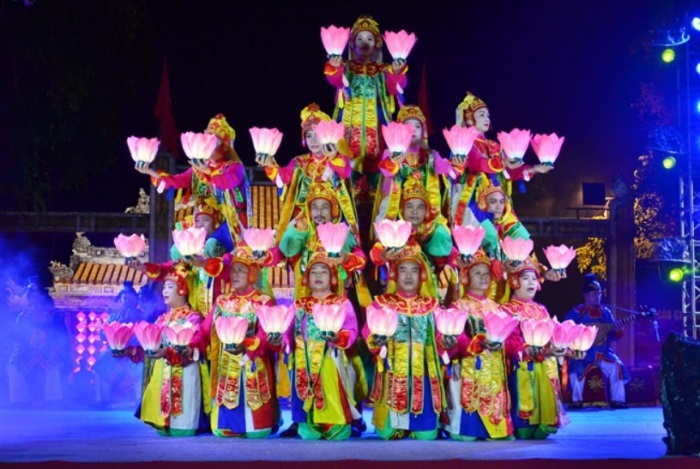
The original name of the dance has a Buddhism origin, and it is translated to “six times of offerings with lanterns”.
The routine includes six routines. Each depicts an offering of incense, flowers, lanterns, tea, fruit, and food.
To the world, the dance is widely known as the Hue Royal Court dance. Hue City used to be Vietnam’s capital and, due to being in the central section of the S-shaped country, the convergent point of cultural quintessences.
After Hue Court music was recognized by UNESCO, the dance paired with it also got more fame.
Surprisingly enough, this dance is the upgraded version of folk dance. Hence, it is obviously more professional and intricate. It consists of several scenes and a lot of maidens in elegant dresses and fine makeup.
Every single one of them is extremely talented since the movements of court dances demand smoothness and precision with no room for mistakes.
Singing is mandatory for court dancers as well. They have to do everything gracefully while maintaining a relaxed and pleasant façade.
To admire the Lantern dance thoroughly, there is no better way than visiting the Imperial Hue City and finding access to the Traditional Art Oper.
Cylindrical Drum Dance (Múa Trống Cơm)
Last but not least, how can we talk about Vietnam’s traditional dances without the oldest dance from the capital city?
It is different from the dances we have discussed because it is meant to worship a human – Phung Hung, the Great King, who has been hailed as the deity protecting the Trieu Khuc village.
For the Cylindrical Drum dance is directly connected to religious rituals and performed in the most sacred place of a village, the dancers must be selected very carefully.
The team includes 8 – 12 young men crossdressing as women and keeping the drum in front of their tummy.
They will pat on the two ends of the drums accordingly to the beat while performing humorous moves to entertain the audience.
When people begin the wine offering inside the communal house, the dancers outside will play with the drum, three turns of beats & dancing accompanying three offering moves.
After such a long time, the dance still maintains its original form and value, even though many art forms from the same era have disappeared or changed to the point we can’t recognize them anymore.
Other Traditional Vietnamese dances
Throughout the Vietnamese traditional dance history, there are so many events being imbued in the arts.
Hence, Vietnam certainly has more than ten dances that we mentioned, yet they might be less popular due to having fewer people celebrating or using them.
Vietnamese Lotus Dance
Considered Vietnam’s national flower, the lotus surely has a spot in traditional dances.
Aside from describing the beauty of the country, the Lotus dance also demonstrates the beauty of Vietnamese women.
Different regions and ethnic groups have different adaptations of this dance, be it the costume or the music.
Cham Dance
It is the signature dance of the Cham group. The music features mostly drums and gongs for solemn and strong sounds, mimicking what most people perceive Cham folks as.
The dance has two separate parts – one for daily life and one for religious practices.
Khen Dance
The name comes from an instrument of the H’Mong people, which is used for expressing thoughts and conveying emotions between humans and deities.
If you are a skilled user of the Khen, you need to know how to dance with it, the faster the better. The movement set includes swings, turns, shrugs, and even rolls on the floor.
Xuan Pha Dance
As a folk dance, the Xuan Pha dance includes dancing, singing, and playing. The dancing looks extremely energetic with various gestures and props, though it also means the expectations for the dancers are very high.
As you dig deeper into the culture of Vietnam, you will encounter many more dances named after the props they use such as the Flag dance, the Platter dance, the Candle dance, the Scarf dance, or the Ribbon dance.
Final Words
Traditional dances in Vietnam are an important part of its history and culture.
The people here are very keen on preserving their traditions and passing them on to younger generations, regardless of all the wars and clashes they had been through.
With all the information collected from our article, you are one step closer to being an expert on Vietnam’s customs and arts!
